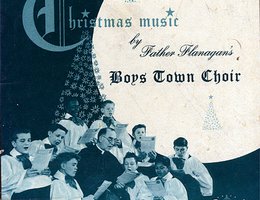

Edward Flanagan was born in County Roscommon, Ireland on July 13, 1886. As a young man Flanagan wanted to be a priest. Father Flanagan moved to America in the 1910s. His first parish was in O’Neill, Nebraska. His second one was in Omaha, Nebraska.
Father Flanagan developed an understanding for the boys and young men who were orphaned by society. He realized that children who were neglected often turned to crime. A guiding principle came from working with these young men. He realized that all boys needed love to be productive citizens. That was why Father Flanagan turned his energy to caring for boys who were neglected.
In 1916, Father Flanagan opened the Workingman’s Hotel in Omaha, a place for homeless young men to live while they looked for work.



With a rent payment of $90 borrowed from a friend, Flanagan opened his first boys’ home on December 12, 1917 in an old Victorian mansion. Flanagan’s archbishop allowed Flanagan to focus on the boys’ home and assigned nuns to help him. The first five boys were homeless newsboys, wards of the court. Many other boys followed, also sent by the court.
However, there were others who came on their own as well.This first home was quickly filled with 50 boys, and Father Flanagan
had to turn many others away.

Father Flanagan knew the need was much greater than this house could hold. In 1918, they moved to a much larger home called the German American Home. One hundred and fifty boys could live in this new home. Father Flanagan now had room to pursue education with the boys, something he knew was very important to their success. Father Flanagan and the nuns would teach in the parlors (living rooms) of the home.
Newsboys sold issues and subscriptions of Father Flanagan’s Boy’s Home Journal, which was published once a month at the cost of 10¢ per issue. The Journal had news about the boys’ activities as well as recipes, jokes, and home remedies, along with a column written by Father Flanagan.

The boys moved in on October 22, 1921. At their new home, Overlook Farm, the boys raised some of their own food in a vegetable garden and had room for a baseball diamond, track, and football field. They planted corn, alfalfa, and potatoes, and tended their fruit orchard and vegetable garden. They also gathered milk from the cows.

By March 1922, business and religious leaders and many Omaha residents
had raised enough money to break ground for a new Boys Town structure.
It was a five-story brick building, which would house the classrooms,
dining hall, gym, dormitory, chapel, and infirmary (hospital).
By 1930, Boys Town was home to 280 boys, and a new $400,000 building was underway to house the trade school, faculty offices, and gym.


The boys’ daily lives were designed to be as "normal" as any boy’s, with school and vocational training in the daytime and hobbies and listening to the radio at night.


Father Flanagan’s success with raising boys came to be widely known over time. Sometimes people learned about Boys Town by listening to Father Flanagan’s radio show or hearing the Boys Town Choir perform.
The widest publicity, however, came from the two movies about Boys Town. Actor Spencer Tracy won an Oscar for his portrayal of Father Flanagan in the movie Boys Town in 1938. A sequel also starring Tracy, Men of Boys Town, was released in 1941.Father Flanagan always believed his work would continue well after him. It has with tremendous success.
With such great publicity, Father Flanagan was able to turn his efforts from fund-raising to developing his youth care ideas. After World War II, he traveled to Japan, Asia, and Europe to share his ideas for youth care. He died in 1948 of a heart attack while traveling in Berlin, Germany.
Father Flanagan was inducted into the Nebraska Hall of Fame in 1965-66.
Learn more about him and its members.
